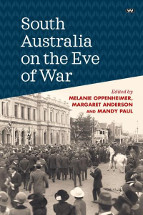South Australia on the eve of war by Melanie Oppenheimer, Margaret Anderson and Mandy Paul

Wakefield Press, 2017. ISBN 9781743054741
In August 2014, a symposium involving History SA, the Professional
Historians Association and the three South Australian Universities
was held to commemorate the beginning of the First World War.
Papers presented have been selected for inclusion in this work which
helps us to better understand the social conditions, political
climate, gender relations and multicultural interactions which
prevailed at the time. These all unavoidably influenced or were
influenced by South Australia's involvement in the Great War and
this book helps us appreciate what life was like in the years and
months prior to this momentous event.
The late John Bannon explains South Australia's position from a
political perspective, having recently evolved from a colony to
being a state within a Federation. Unfortunately, whilst supporting
National progress, South Australia had limited voice and power in
comparison with the more powerful Eastern States.
Another chapter considers conditions for women. It's noted that on
the eve of war, birth rates were declining as women accessed various
forms of contraception and sought education and increasing work
opportunities. Sadly the situation for many remained unchanged with
unmarried pregnant women seeking illegal abortion, travelling to
undergo anonymous birthing and even secretly disposing of babies.
More mundane but positive developments in the home such as the
connection of gas and electricity improved family life and eased the
burden for women somewhat.
The euphemistic 'Protection' of Aboriginal people which in reality
constituted a powerful means of state control is explained in terms
of the regulation of place of residence, employment, personal
relationships and custody of children. The laws and regulations
which prescribed how Indigenous lived were clearly racist and
ignorant but also incredibly divisive in terms of segregating
Indigenous people and consigning them to specific reserves such as
Point Pearce. It is pointed out that whilst Aboriginal people had
voting rights, their citizenship was compromised in practical terms
through administration. The trauma caused by the forced removal of
children is also well known and was practiced in South Australia at
this time.
Other chapters have an agricultural focus. The British Farm
Apprentice scheme was implemented with British boys migrating to
serve the needs of an industry which was labour intensive and crying
out for employees. Life on the Eyre Peninsula, community development
and the importance of the region to the State's economy is also
considered in some detail.
The final chapters in this work focus on the contribution by South
Australians from differing nationalities and the various tensions
present prior to the Great War. We learn of the Indian community's
objection to the Immigration Restriction Act (White Australia
Policy) which expressly excluded migrants from Asia and Africa.
Whilst officially restricting selected nationalities, successive
governments had allowed labourers from those same countries when the
demand for labour under harsh conditions was required, e.g. building
railways. Economic downturn however caused renewed focus on the
restrictions and increasing tension within the wider community.
Reference is also made to what is described as the 'myth' of South
Australian Germans' bid to escape religious persecution. The author
notes that economic factors were equally important in motivating
German people to seek better lives and also emphasises that the S.A.
German population was not in fact united by heredity and religious
belief. It would appear that whilst German cultural influence and
tradition was evident in many aspects of life, generally the
migrants had assimilated to the point that they felt little
allegiance to their former country by the outbreak of war. Being
associated with the enemy in the pending conflict and considered
potentially hostile in their own right clearly caused division
however, and South Australian Germans suffered during and after the
war accordingly.
South Australians of Irish Catholic descent could also have been
regarded with suspicion prior to war, given the agitation for
political independence in Ireland. Local Irish support for the
Empire in opposition to Germany appears to have been almost
universal and was accepted to the extent that their allegiance was
accepted. The author notes however that this and military service by
Irish South Australians was not enough to overcome decades of
prejudice by the majority of citizens of English descent.
This book presents well researched and considered points of view on
varied aspects of South Australian life by contributors who are
clearly knowledgeable in their field.
Rob Welsh